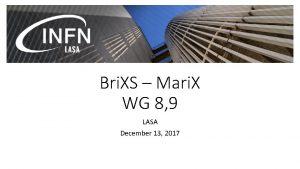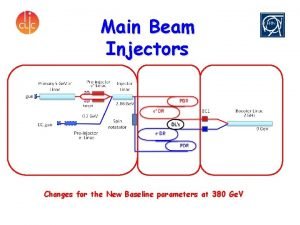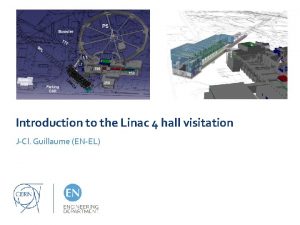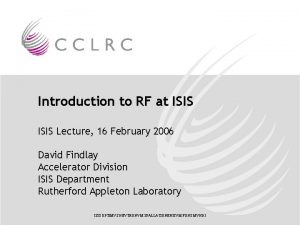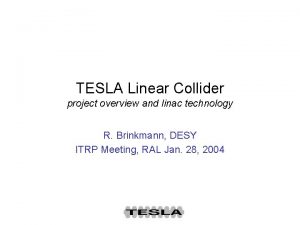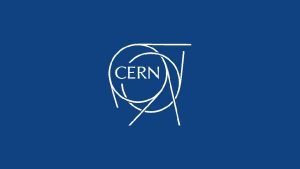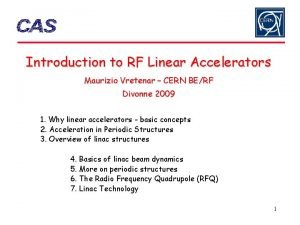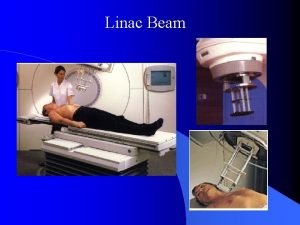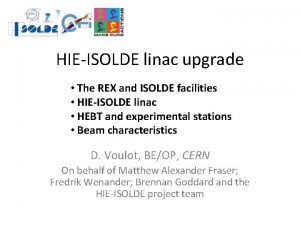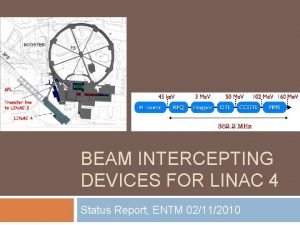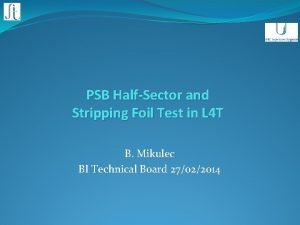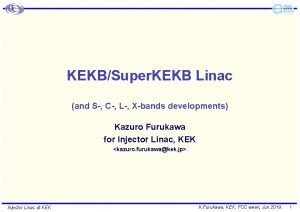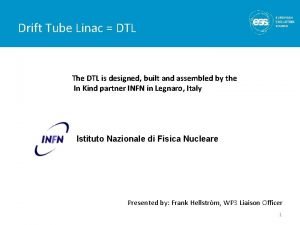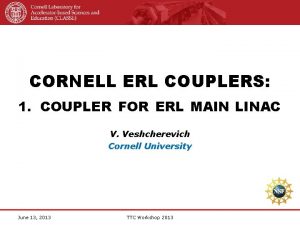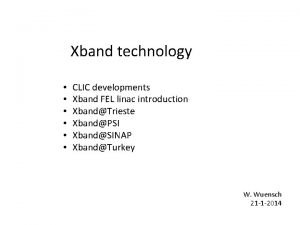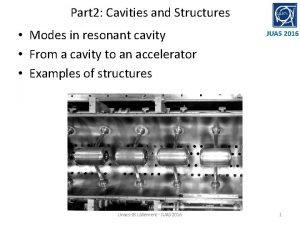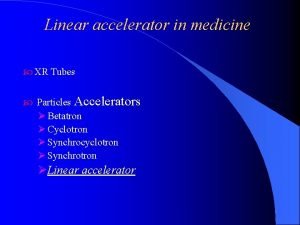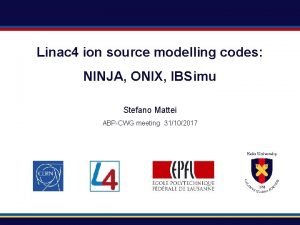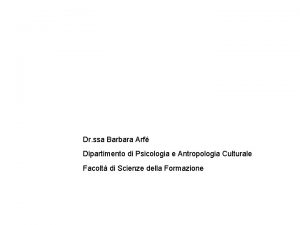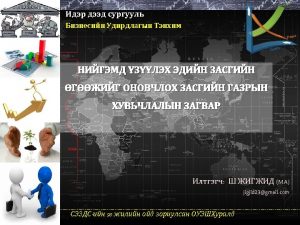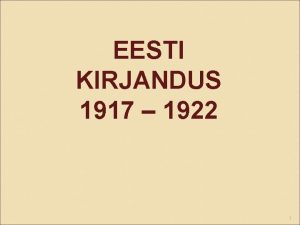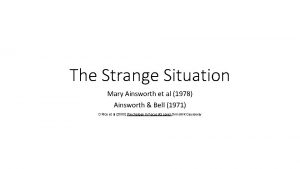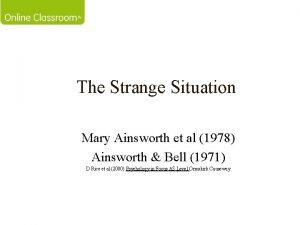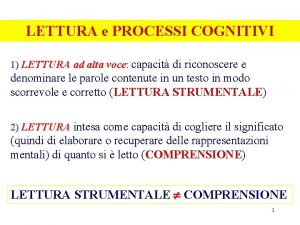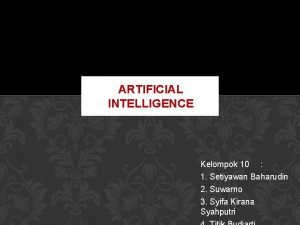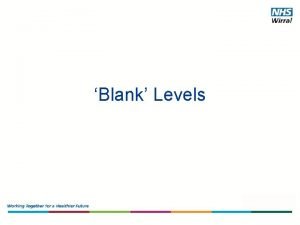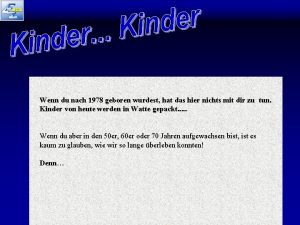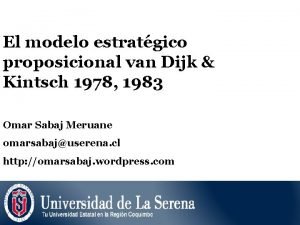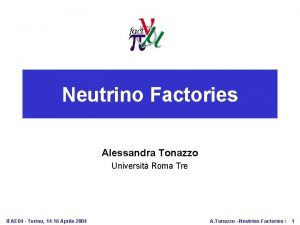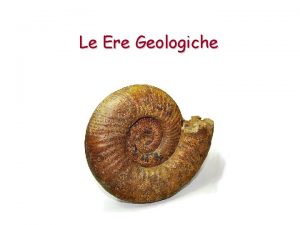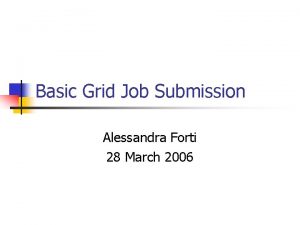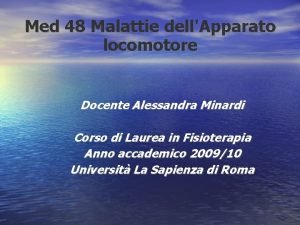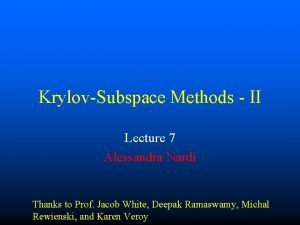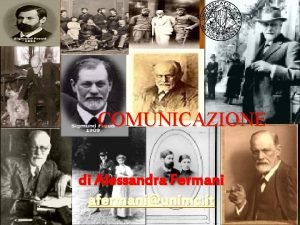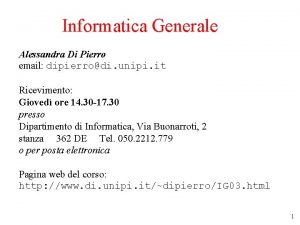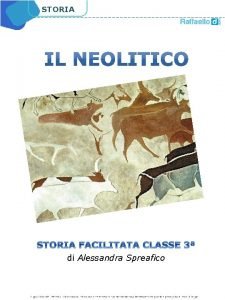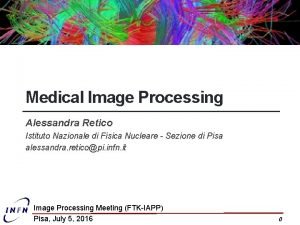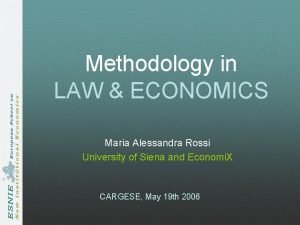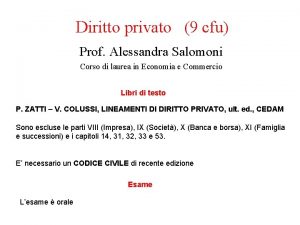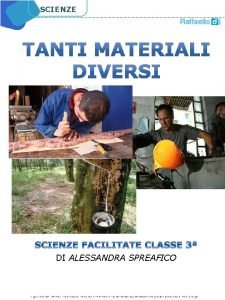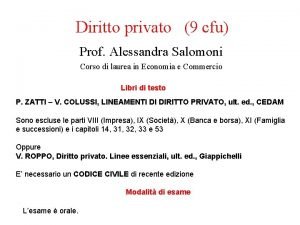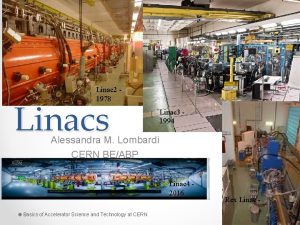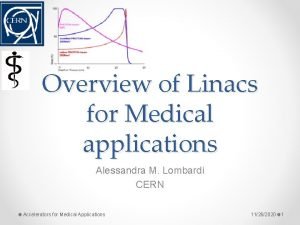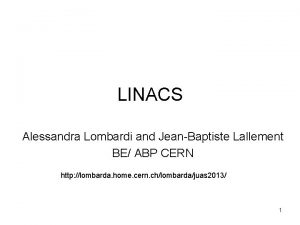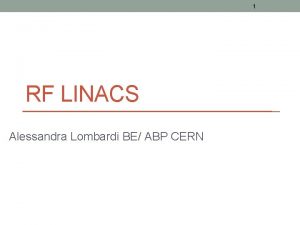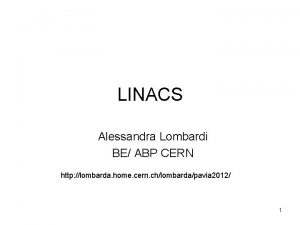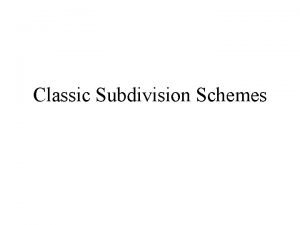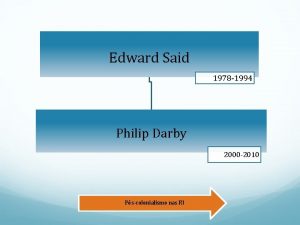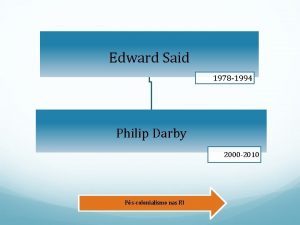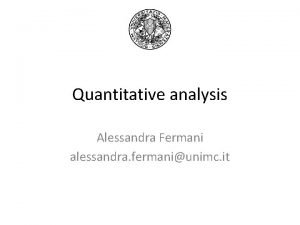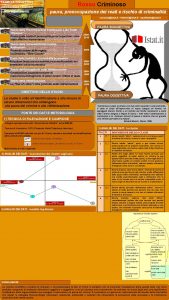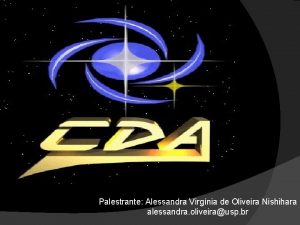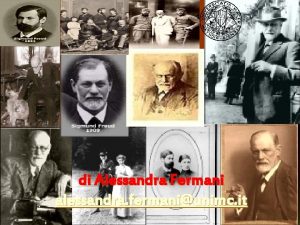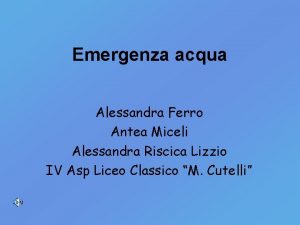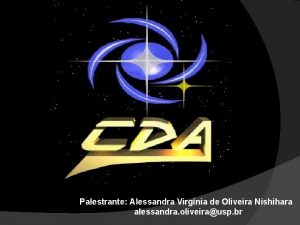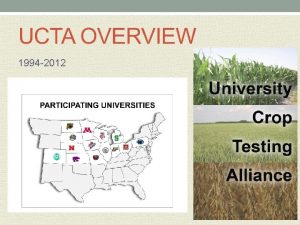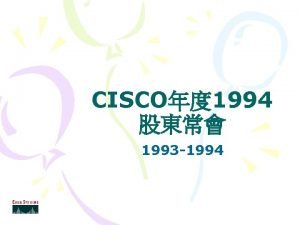Linac 2 1978 Linacs Linac 3 1994 Alessandra




























































- Slides: 60

Linac 2 1978 Linacs Linac 3 1994 Alessandra M. Lombardi CERN BE/ABP Linac 4 2016 Basics of Accelerator Science and Technology at CERN Rex Linac 2/24/2021 1

outline • Introduction and focus of the lecture o WHAT is a LINAC, WHEN was it invented and HOW does it work • A selection of the CERN LINACS o Linac 2, 3, 4 : hadron linacs injecting into a synchrotron o (Rex) – will not talk about this o (Clic/ctf 3)- will not talk about this • LINAC building blocks o Acceleration : Radio Frequency Cavities o Focusing : Quadrupoles Basics of Accelerator Science and Technology at CERN 2/24/2021 2

What is a linac • LINear ACcelerator : single pass device that increases the energy of a charged particle by means of a (radio frequency) electric field and it is equipped with magnetic elements (quadrupoles, solenoids, bending magnets) to keep the charged particle on a given trajectory. • Motion equation of a charged particle in an electromagnetic field Basics of Accelerator Science and Technology at CERN 2/24/2021 3

What is a linac-cont’ed Relativistic or not type of focusing type of particle : charge couples with the field, mass slows the acceleration Basics of Accelerator Science and Technology at CERN type of RF structure 2/24/2021 4

Type of particles • electron, mass 0. 511 Me. V, quickly relativistic, easi(er) to accelerate • proton, mass 938. 28 Me. V, q/m=1 • lead ions , mass 195. 16 Ge. V , q/m=1/8. 32 (in the linac, ) • Xenon ions , mass 122 Ge. V, q/m=1/5. 8 At 0. 1 Me. V beta =0. 015, gamma= 1 Basics of Accelerator Science and Technology at CERN At 50 Me. V beta =0. 3 , gamma=1. 05 At 160 Me. V beta =0. 52 , gamma=1. 17 2/24/2021 5

Velocity of the particles Synchronicity with the accelerating electric field (accelerator is single purpose) Space charge effects (more severe the lower the velocity) 1) Geometry of the accelerator has to be adapted step-by-step 2) The phase of the radio frequency field has to be optimised independently 1) The beam cannot be compressed in a small volume 2) The beam quality degradation is more severe Basics of Accelerator Science and Technology at CERN 2/24/2021 6

When ? A short history • Acceleration by time varying electromagnetic field overcomes the limitation of static acceleration • First experiment towards an RF linac : Wideroe linac 1928 on a proposal by Ising dated 1925. A bunch of potassium ions were accelerated to 50 ke. V in a system of drift tubes in an evacuated glass cylinder. The available generator provided 25 ke. V at 1 MHz. • First realization of a linac : 1931 by Sloan and Lawrence at Berkeley laboratory • From experiment to a practical accelerator : Wideroe to Alvarez • to proceed to higher energies it was necessary to increase by order of magnitude the frequency and to enclose the drift tubes in a RF cavity (resonator) • this concept was proposed and realized by Luis Alvarez at University of California in 1955 : A 200 MHz 12 m long Drift Tube Linac accelerated protons from 4 to 32 Me. V. • the realization of the first linac was made possible by the availability of highfrequency power generators developed for radar application during World War Basics of Accelerator Science and Technology at CERN 2/24/2021 7

Why not an electrostatic field? 750 ke. V Radio Frequency accelerator (2 m long, 0. 5 m across) 750 k. V Cockcroft-Walton Basics of Accelerator Science and Technology at CERN 2/24/2021 8

How? principle of an RF linac 1)RF power source: generator of electromagnetic wave of a specified frequency. It feeds a 2)Cavity : space enclosed in a metallic boundary which resonates with the frequency of the wave and tailors the field pattern to the 3)Beam : flux of particles that we push through the cavity when the field is maximized as to increase its 4)Energy. RF power source Wave guide Power coupler Cavity Basics of Accelerator Science and Technology at CERN 2/24/2021 9

LINAC 2 - 50 Me. V protons LINAC 2 machine layout- 200 MHz Drift Tube Linac Pre-injector Basics of Accelerator Science and Technology at CERN 50 Me. V (beta=0. 3) 0. 750 Me. V (beta=0. 04) 34 m 3 Tanks 3 rf power source: 5 MW 130 quadrupoles 2 steerers 5 m Source 2 solenoids Radio Frequency Quadrupole 4 EM Quadrupoles 2 Cavities 2/24/2021 10

LINAC 3 - heavy ions LINAC 3 machine layout- 100 and 200 MHz IH –LINAC Pre-injector 4. 2 Me. V/u (beta=0. 094) 0. 0025 Me. V /u (beta=0. 0023) 7 m 3 Tanks 3 rf power source: 5 MW 12 quadrupoles 2 steerers 10 m ECRIS Source with multiple charges 2 solenoids Radio Frequency Quadrupole 8 EMQuadrupoles 2 Cavities 2 bendings Stripper: Pb 29+ Pb 54+ Basics of Accelerator Science and Technology at CERN 2/24/2021 11

LINAC 4 – 160 Me. V LINAC 4 machine layout- 352 MHz Π-mode CC-DTL Drift Tube L Pre-injector 160 Me. V (beta=0. 52) 100 Me. V (beta=0. 42) 50 Me. V (beta=0. 3) 3 Me. V (beta=0. 08) 23 m 12 Modules 8 Klystrons: 12 MW 12 Quadrupoles 12 steerer 25 m 7 Modules 7 Klystrons : 7 MW 21 Quadrupoles 7 steerers 19 m 3 Tanks 3 Klystrons: 5 MW 115 quadrupoles 2 steerers 9 m Source(s) 2 solenoids Radio Frequency Quadrupole 11 EMQ 3 Cavities 2 Chopper units In-line dump beam 2/24/2021 12

What is a linac-cont’ed From 1 to 1. 17 type of focusing q/m=1/1 to q/m=1/8 type of RF structure Basics of Accelerator Science and Technology at CERN 2/24/2021 13

Types of RF structures Type of structure Used at CERN in Radio Frequency Quadrupole LINAC 2, LINAC 3, LINAC 4, LINAC 5, REX-ISOLDE Interdigital-H structure LINAC 3 , REX-ISOLDE Drift Tube Linac LINAC 2, LINAC 4, LINAC 5 Cell. Coupled DTL LINAC 4 PIMS LINAC 4 Basics of Accelerator Science and Technology at CERN 2/24/2021 14

wave equation -recap • Maxwell equation for E and B field: • In free space the electromagnetic fields are of the transverse electro magnetic, TEM, type: the electric and magnetic field vectors are to each other and to the direction of propagation. • In a bounded medium (cavity) the solution of the equation must satisfy the boundary conditions : • In a cavity we have Tranverse Electric (TE modes ) or Transverse magnetic (TM modes) Basics of Accelerator Science and Technology at CERN 2/24/2021 15

n : azimuthal, m : radial l longitudinal component dipole mode used in the IH structures Basics of Accelerator Science and Technology at CERN quadrupole mode used in Radio Frequency Quadrupole 2/24/2021 16

n : azimuthal, m : radial l longitudinal component TM 010 mode , most commonly used accelerating mode Basics of Accelerator Science and Technology at CERN 2/24/2021 17

Radio Frequency Quadrupoles Basics of Accelerator Science and Technology at CERN 2/24/2021 18

+ transverse field in an RFQ alternating gradient focussing structure with period length (in half RF period the particles have travelled a length /2 ) + - - + + - Basics of Accelerator Science and Technology at CERN Beam goes into the paper in between the 4 2/24/2021 19 vanetips

transverse field in an RFQ animation!!!!! Basics of Accelerator Science and Technology at CERN 2/24/2021 20

acceleration in RFQ longitudinal modulation on the electrodes creates a longitudinal component in the TE mode Basics of Accelerator Science and Technology at CERN 2/24/2021 21

Modulation and Rhol Looking in from the RF port : these are adjacent vanes Basics of Accelerator Science and Technology at CERN 2/24/2021 22

important parameters of the RFQ type of particle limited by sparking Accelerating efficiency : fraction of the field deviated in the longitudinal direction (=0 for un-modulated electrodes) Basics of Accelerator Science and Technology at CERN Transverse field distortion due to modulation (=1 for un-modulated electrodes) cell length transit time factor 2/24/2021 23

. . . and their relation focusing efficiency accelerating efficiency a=bore radius, , =relativistic parameters, c=speed of light, f= rf frequency, I 0, 1=zero, first order Bessel function, k=wave number, =wavelength, m=electrode modulation, m 0=rest q=charge, r= average transverse beam dimension, r 0=average bore, V=vane voltage Basics of Accelerator Science and Technology at CERN 2/24/2021 24

• • RFQ The resonating mode of the cavity is a focusing mode (TE mode) Alternating the voltage on the electrodes produces an alternating focusing channel A longitudinal modulation of the electrodes produces a field in the direction of propagation of the beam which bunches and accelerates the beam Both the focusing as well as the bunching and acceleration are performed by the RF field Not very efficient accelerator The RFQ is the only linear accelerator that can accept a low energy CONTINOUS beam of particles 1970 Kapchinskij and Teplyakov propose the idea of the radiofrequency quadrupole ( I. M. Kapchinskii and V. A. Teplvakov, Prib. Tekh. Eksp. No. 2, 19 (1970)) Basics of Accelerator Science and Technology at CERN 2/24/2021 25

Interdigital H structure Basics of Accelerator Science and Technology at CERN 2/24/2021 26

Interdigital H structure the mode is the TE 110 Basics of Accelerator Science and Technology at CERN 2/24/2021 27

Interdigital H structure • stem on alternating side of the drift tube force a longitudinal field between the drift tubes • focalisation is provided by quadrupole triplets places OUTSIDE the drift tubes Basics of Accelerator Science and 2/24/2021 or OUTSIDE the tank Technology at CERN 28

IH • The resonating mode of the cavity is a dipole mode • The cavity is equipped with thin drift tubes. • Alternating the stems on each side of the drift tubes produces a field in the direction of propagation of the beam which accelerates the beam • Focusing is provided by quadrupole triplets located inside the tank in a dedicated section • Very efficient in the low beta region (( 0. 02 to 0. 08 ) and low frequency (up to 200 MHz) • not for high intensity beam due to long focusing period • ideal for low beta ion acceleration Basics of Accelerator Science and Technology at CERN 2/24/2021 29

Drift Tube Linac Basics of Accelerator Science and Technology at CERN 2/24/2021 30

DTL : electric field Mode is TM 010 Basics of Accelerator Science and Technology at CERN 2/24/2021 31

Synchronous particle • it’s the (possibly fictitious) particle that we use to calculate and determine the phase along the accelerator. It is the particle whose velocity is used to determine the synchronicity with the electric field. Design for that particle and provide longitudinal focusing so that the other stick with it! Footer Text 2/24/2021 32

Perfect synchronicity • Footer Text 2/24/2021 33

Perfect synchronicity • The absolute phase ji and the velocity bi-1 of this particle being known at the entrance of cavity i, its RF phase fi is calculated to get the wanted synchronous phase fsi, • the new velocity bi of the particle can be calculated from, if the phase difference between cavities i and i+1 is given, the distance Di between them is adjusted to get the wanted synchronous phase fsi+1 in cavity i+1. if the distance Di between cavities i and i+1 is set, the RF phase fi of cavity i+1 is calculated to get the wanted synchronous phase fsi+1 in it. RF phase fi-1 fi+1 fi Particle velocity bsi-1 bsi Distances Di-1 Di Synchronous phase fsi-1 fsi+1 Cavity number i-1 i i+1 Synchronism condition : 34

Synchronous structures 35

Beta vs W beta_protons 0. 45 0. 4 beta = velocity/c 0. 35 0. 3 0. 25 0. 2 0. 15 0. 1 0. 05 0 0 Footer Text 20 40 60 80 kinetic energy (Me. V) 100 120 2/24/2021 36

Almost perfect synchronicity • for simplifying construction and therefore keeping down the cost, cavities are not individually tailored to the evolution of the beam velocity but they are constructed in blocks of identical cavities (tanks). several tanks are fed by the same RF source. • This simplification implies a “phase slippage” i. e. a motion of the centre of the beam. The phase slippage is proportional to the number of cavities in a tank and it should be carefully controlled for successful acceleration. 37

phase slippage Lcavity = βgλ/2 particle enters the cavity with βs< βg. It is accelerated the particle has not left the cavity when the field has changed sign : it is also a bit decelerated the particle arrives at the second cavity with a “delay” . . . . and so on we have to optimize the initial phase for minimum phase slippage for a given velocity there is a maximum number of cavity we can accept in a tank 38

Adapting the structure to the velocity of the particle • Case 1 : the geometry of the cavity/structure is continuously changing to adapt to the change of velocity of the “synchronous particle” • Case 2 : the geometry of the cavity/structure is adapted in step to the velocity of the particle. Loss of perfect synchronicity, phase slippage. • Case 3 : the particle velocity is beta=1 and there is no problem of adapting the structure to the speed. 39

Cell Coupled-DTL Single Accelerating CCDTL tank 1 Power coupler / klystron ABP group seminar 16 march 06 Module

Side Coupled Linac Chain of cells, coupled via slots and off-axis coupling cells. Invented at Los Alamos in the 60’s. Operates in the p/2 mode (stability). CERN SCL design: Each klystron feeds 5 tanks of 11 accelerating cells each, connected by 3 -cell bridge couplers. Quadrupoles are placed between tanks.

PI-mode structure beam Basics of Accelerator Science and Technology at CERN 2/24/2021 42

Beam centre phase in LINAC 4 Basics of Accelerator Science and Technology at CERN 2/24/2021 43

How to choose Basics of Accelerator Science and Technology at CERN 2/24/2021 44

cavity geometry and related parameters definition field y beam x Cavity L=cavity length z 1 -Maximum field/average field 2 -Shunt impedance 3 -Quality factor 4 -Filling time 5 -Transit time factor Basics of Accelerator Science and Technology at CERN 6 -Effective shunt impedance 2/24/2021 45

Average electric field • Average electric field ( E 0 measured in V/m) is the space average of the electric field along the direction of propagation of the beam in a given moment in time when F(t) is maximum. • physically it gives a measure how much field is available for acceleration • it depends on the cavity shape, on the resonating mode and on the frequency Basics of Accelerator Science and Technology at CERN 2/24/2021 46

What limits the field Kilpatrick sparking criterion f = 1. 64 E 2 exp (-8. 5/E) GUIDELINE nowadays : peak surface field up to 2*kilpatrick field Basics of Accelerator Science and Technology at CERN Quality factor for normal conducting cavity is Epeak/Eo. T 2/24/2021 47

The higher the frequency 1990 LINAC 2 RFQ 2 200 MHz 0. 5 Me. V /m Weight : 900 kg/m Ext. diametre : ~45 cm Beam current: 200 m. A Basics of Accelerator Science and Technology at CERN 2007 LINAC 4 RFQ 352 MHz 1 Me. V/m Weight : 400 kg/m Ext. diametre : 29 cm Beam current : 80 A 2014 HF RFQ 750 MHz 2. 5 Me. V/m Weight : 100 kg/m Ext. diametre : 13 cm Beam current : 0. 1 m. A 2/24/2021 48

Transit time factor • transit time factor ( T, dimensionless) is defined as the maximum energy gain per charge of a particles traversing a cavity over the average voltage of the cavity. • Write the field as • The energy gain of a particle entering the cavity on axis at phase φ is • Basics of Accelerator Science and Technology at CERN 2/24/2021 49

cavity parameters-5 • assume constant velocity through the cavity (APPROXIMATION!!) we can relate position and time via • we can write the energy gain as • and define transit time factor as T depends on the particle velocity and on the gap length. IT DOESN”T depend on the field 50

Transit time factor if we don’t get the length right we can end up decelerating!!! Basics of Accelerator Science and Technology at CERN 2/24/2021 51

effective shunt impedance • • Effective shunt impedance ( Z measured in Ω/m) is defined as the ratio of the average effective electric field squared (E 0 T ) to the power (P) per unit length (L) dissipated on the wall surface. it is independent of the field level and cavity length, it depends on the cavity mode and geometry and on the velocity of the particle to be accelerated measure if the structure is optimized and adapted to the velocity of the particle to be accelerated Measure of how much energy a charged particle can gain for 1 w of power when travelling over 1 m of structure. Basics of Accelerator Science and Technology at CERN 2/24/2021 52

overview take with CAUTION! Ideal range frequency of beta Effective gradient Particles RFQ Low!!! - 0. 05 40 -400 MHz 1 MV/m (350 MHz) Ions / protons IH 0. 02 to 0. 08 40 -200 MHz 4. 5 MV/m (200 MHz) Ions and also protons DTL 0. 04 -0. 5 3. 5 MV/m (350 MHz) Ions / protons 20 MV/m (3000 MHz) protons SCL 100 -400 MHz Ideal 800 - 3000 Beta=1 MHz But as low Basics of Accelerator Science and as beta 0. 3 Technology at CERN 2/24/2021 53

What is a linac-cont’ed Relativistic or not type of focusing type of particle : charge couples with the field, mass slows the acceleration Basics of Accelerator Science and Technology at CERN type of RF structure 2/24/2021 54

Magnetic quadrupoles Electro. MQ Basics of Accelerator Science and Technology at CERN Permanent MQ 2/24/2021 55

Focusing force B=magnetic field/F=force Positively charged particles going into the screen Basics of Accelerator Science and Technology at CERN 2/24/2021 56

Magnetic quadrupole Magnetic field Magnetic force Focusing in one plan, defocusing in the other y envelope x envelope Basics of Accelerator Science and Technology at CERN sequence of focusing and defocusing quadrupoles 2/24/2021 57

F 0 D 0 focusing D F D 1 F 2 34 D 5 6 7 8 F D F 1 2 3 4 5 6 7 8 The beam is matched, after every period, the twiss parameters are identical. 58

Building blocks-recap Footer Text 2/24/2021 59

Choices / Questions Frequency? Frequency and size Frequency and acceptance Frequency and maximum accelerating field Frequency and duty cycle RFQ output energy? Into which structure do we inject How long is the RFQ (compared to wavelenght) Continue with TE mode or switch to TM mode? Start thinking about transverse focusing Think about the final energy Think about the energy at the transition (NB treshold for copper activation is around few Me. V) At what energy we Quasi-synchronous condition start standardising the RF structures PMQ or EMQ? Footer Text Cheap and easy or maximum flexibility 2/24/2021 60
 Linac
Linac Linac
Linac Neltun
Neltun Isis mcr news
Isis mcr news Linac
Linac Linac 4
Linac 4 Maurizio vretenar
Maurizio vretenar Linac treatment head
Linac treatment head Linac
Linac Beam stopper linac
Beam stopper linac Linac 4
Linac 4 Linac
Linac Linac 4
Linac 4 Linac
Linac Linac
Linac Linac 4
Linac 4 Klystron vs magnetron linac
Klystron vs magnetron linac Linac
Linac Motivazione intrinseca
Motivazione intrinseca Iso 1978
Iso 1978 Mussa and rosen 1978
Mussa and rosen 1978 Kirmus
Kirmus 2010 - 1978
2010 - 1978 Ainsworth 1978
Ainsworth 1978 Mary ainsworth 1978
Mary ainsworth 1978 1978 po rzymsku
1978 po rzymsku Wenn du vor 1978 geboren bist
Wenn du vor 1978 geboren bist Sheridan and king puppy experiment
Sheridan and king puppy experiment Deklarasi alma ata 1978
Deklarasi alma ata 1978 1978
1978 Coltheart 1978
Coltheart 1978 şebnem ünal kimdir
şebnem ünal kimdir Vredesonderhandelingen 1978
Vredesonderhandelingen 1978 Bellman 1978
Bellman 1978 About blank berlin
About blank berlin Munby 1978
Munby 1978 Wenn du vor 1978 geboren bist
Wenn du vor 1978 geboren bist Cold water kills
Cold water kills Teoría de la macroestructura
Teoría de la macroestructura Ben je geboren voor 1978
Ben je geboren voor 1978 1969 1970 1971 1972 1973 1974 1975 1976 1977 1978
1969 1970 1971 1972 1973 1974 1975 1976 1977 1978 1978-1941
1978-1941 Alessandra laranja
Alessandra laranja Alessandra tonazzo
Alessandra tonazzo Era archeozoica alessandra livreeo
Era archeozoica alessandra livreeo Alessandra forti
Alessandra forti Alessandra minardi
Alessandra minardi Alessandra nardi
Alessandra nardi Alessandra fermani
Alessandra fermani Alessandra di pierro
Alessandra di pierro Allevamento nel neolitico - scuola primaria
Allevamento nel neolitico - scuola primaria Alessandra retico
Alessandra retico Maria alessandra rossi
Maria alessandra rossi Hi daniel my name's alessandra
Hi daniel my name's alessandra Alessandra salomoni
Alessandra salomoni Alessandra bragagnini
Alessandra bragagnini Oggetti fatti con materiali naturali
Oggetti fatti con materiali naturali Alessandra aloisi
Alessandra aloisi Dott ssa amato pediatra
Dott ssa amato pediatra Alessandra salomoni
Alessandra salomoni Alessandra cenerini
Alessandra cenerini
